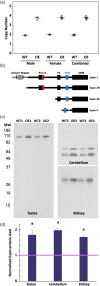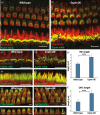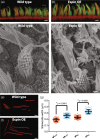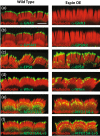Espin overexpression causes stereocilia defects and provides an anti-capping effect on actin polymerization
- PMID: 35844198
- PMCID: PMC9796729
- DOI: 10.1002/cm.21719
Espin overexpression causes stereocilia defects and provides an anti-capping effect on actin polymerization
Abstract
Stereocilia are actin-based projections of hair cells that are arranged in a step like array, in rows of increasing height, and that constitute the mechanosensory organelle used for the senses of hearing and balance. In order to function properly, stereocilia must attain precise sizes in different hair cell types and must coordinately form distinct rows with varying lengths. Espins are actin-bundling proteins that have a well-characterized role in stereocilia formation; loss of function mutations in Espin result in shorter stereocilia and deafness in the jerker mouse. Here we describe the generation of an Espin overexpressing transgenic mouse line that results in longer first row stereocilia and discoordination of second-row stereocilia length. Furthermore, Espin overexpression results in the misregulation of other stereocilia factors including GNAI3, GPSM2, EPS8, WHRN, and MYO15A, revealing that GNAI3 and GPSM2 are dispensable for stereocilia overgrowth. Finally, using an in vitro actin polymerization assay we show that espin provides an anti-capping function that requires both the G-actin binding WH2 domain as well as either the C-terminal F-actin binding domain or the internal xAB actin-binding domain. Our results provide a novel function for Espins at the barbed ends of actin filaments distinct from its previous known function of actin bundling that may account for their effects on stereocilia growth.
Keywords: actin; espin; hair cell; stereocilia.
© 2022 The Authors. Cytoskeleton published by Wiley Periodicals LLC.
Conflict of interest statement
The authors have no conflicts of interest.
Figures





Similar articles
-
The actin cytoskeleton in hair bundle development and hearing loss.Hear Res. 2023 Sep 1;436:108817. doi: 10.1016/j.heares.2023.108817. Epub 2023 May 26. Hear Res. 2023. PMID: 37300948 Free PMC article. Review.
-
Roles of the espin actin-bundling proteins in the morphogenesis and stabilization of hair cell stereocilia revealed in CBA/CaJ congenic jerker mice.PLoS Genet. 2011 Mar;7(3):e1002032. doi: 10.1371/journal.pgen.1002032. Epub 2011 Mar 24. PLoS Genet. 2011. PMID: 21455486 Free PMC article.
-
Myosin IIIa boosts elongation of stereocilia by transporting espin 1 to the plus ends of actin filaments.Nat Cell Biol. 2009 Apr;11(4):443-50. doi: 10.1038/ncb1851. Epub 2009 Mar 15. Nat Cell Biol. 2009. PMID: 19287378 Free PMC article.
-
The deaf jerker mouse has a mutation in the gene encoding the espin actin-bundling proteins of hair cell stereocilia and lacks espins.Cell. 2000 Aug 4;102(3):377-85. doi: 10.1016/s0092-8674(00)00042-8. Cell. 2000. PMID: 10975527 Free PMC article.
-
Espins and the actin cytoskeleton of hair cell stereocilia and sensory cell microvilli.Cell Mol Life Sci. 2006 Oct;63(19-20):2329-41. doi: 10.1007/s00018-006-6148-x. Cell Mol Life Sci. 2006. PMID: 16909209 Free PMC article. Review.
Cited by
-
The role of Espin in the stereocilia regeneration and protection in Atoh1-overexpressed cochlear epithelium.Cell Prolif. 2023 Nov;56(11):e13483. doi: 10.1111/cpr.13483. Epub 2023 Apr 21. Cell Prolif. 2023. PMID: 37084708 Free PMC article.
-
The actin cytoskeleton in hair bundle development and hearing loss.Hear Res. 2023 Sep 1;436:108817. doi: 10.1016/j.heares.2023.108817. Epub 2023 May 26. Hear Res. 2023. PMID: 37300948 Free PMC article. Review.
References
-
- Agrawal, Y. , Carey, J. P. , Della Santina, C. C. , Schubert, M. C. , & Minor, L. B. (2009). Disorders of balance and vestibular function in US adults: Data from the National Health and nutrition examination survey, 2001‐2004. Archives of Internal Medicine, 169, 938–944. 10.1001/archinternmed.2009.66 - DOI - PubMed
-
- Blackwell, D. L. , Lucas, J. W. , & Clarke, T. C. (2014). Summary health statistics for U.S. adults: National health interview survey, 2012. Vital and Health Statistics, 10, 1–161. - PubMed
Publication types
MeSH terms
Substances
Grants and funding
LinkOut - more resources
Full Text Sources
Miscellaneous

